Interview with Dr. Rose Bongiovanni, Director of Customer Development, Phonak Hearing Systems
Share:
Topic: Latest Releases Including the Exélia, Naída, Inspiro, iCom, myPilot, and iCube
Paul Dybala: Hello, everyone. This is Dr. Paul Dybala with Audiology Online. Today, we have Dr. Rose Bongiovanni, the Director of Customer Development for Phonak. Rose, welcome, and thank you for coming on Audiology Online.
Rose Bongiovanni: Thank you. It is a pleasure to be here Paul.
Dybala: Before we discuss some of the exciting new products that Phonak has released, I would like to start by having you tell us a little bit about yourself and what you do for Phonak.
Bongiovanni: I am the Director of Customer Development, and my job is to oversee training, education, and design strategies to ensure that Phonak maintains its personal touch to all of our customers. It is a job I truly enjoy, as we have great customers!
Dybala: Thanks. Recently, Phonak announced the release of a CORE-based chip technology for hearing aids. This platform would enable, among other things, wireless capabilities in Phonak hearing aids. Could you tell us more about CORE?
Bongiovanni: CORE, as you said, is our new chip that is a brand new platform. The acronym stands for Communication Optimized Real audio Engine. It is actually three chips in one that is very, very small in its packaging. It allows us to offer never before seen performance characteristics, and it also affords us the ability to offer digital wireless. This includes wireless communication between left and right hearing aids and/or communication between the hearing aids and leading-edge accessories.
Dybala: You also have three new products that you are rolling out around this new CORE based chip technology, the Exélia, the Naída, and the Inspiro. Can you give us a brief overview of what these three new products are and what they do?



Bongiovanni: Yes. Exélia is our new premium product. We have identified three main drivers to ensure maximum client benefit: 1) performance, the hearing aid has to perform in as many listening environments as possible;2) control, for those people that want control, although it is designed to be an automatic system;and 3) connectivity, which is where the digital wireless function comes in.

The Phonak Exélia
The Naída is a product designed for people with severe to profound hearing loss. Many times, as new technologies develop, that population of patients is not able to take advantage of the new technology. However, we now have the Naída, which is available in two price points, the Naída V - business class and the Naída III - economy class. It also is available as an Ultra Power, utilizing a 675 battery and as a Super Power, utilizing a 13 battery.
The Naída provides more hearing for the severe to profound population, a very slim design, and it is also water resistant.
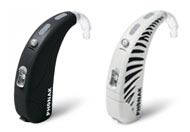
The Phonak Naída Ultra Power Hearing System
Dybala: Water-resistance is a big factor, especially for the pediatric population.
Bongiovanni: It is a very important feature. In addition, we are introducing a new integrated FM boot with Naida for those children utilizing FM in the classroom, and it maintains its water resistance capability.

Naída Hearing Instrument with Inspiro Dynamic FM Receivers
Dybala: Tell us about your new FM device, the Inspiro.
Bongiovanni: Yes, it is a new FM device. One of the main features of this new platform is Dynamic FM. As we all know, the classroom can be a very noisy place, and sometimes, it is still challenging for children to hear the teacher's voice in that noisy classroom setting. This product, with its Dynamic FM, is designed to keep its dynamic range above the classroom noise. Additional gain is added if the background noise level increases. The dynamic range 'slides' lower when the classroom is quieter, higher when the classroom is noisier.
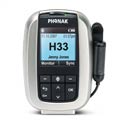
Inspiro Transmitter for Schools
Dybala: Let's talk some more about your new premium product, the Exélia. What has Phonak done to enhance performance in this new premium product?
Bongiovanni: There are three main performance characteristics of Exélia. First is the SoundFlow Premium, the second is VoiceZoom, and the third is WhistleBlock. We also maintained many of the characteristics of our previous platforms that perform so well, such as our SoundRelax and Real Ear Sound. In addition, Echo Block, for those people in reverberant situations, and WindBlock, for wind noise management, which stays in a directional mode when wind noise is present.
Dybala: Tell me more about SoundFlow Premium.
Bongiovanni: As you know, Phonak has developed and utilized a multi based platform. In other words, as in Savia Art, we begin with four base programs that activate automatically depending on the environment: calm, comfort in noise, speech in noise, and music. One advantage to this approach is the ability to independently fine tune each 'base' thus solving one problem without creating another.
With the Exélia technology, we have taken multi-base to the next level with our SoundFlow Premium. Instead of choosing one of the base programs that is the best compromise for a given environment, SoundFlow utilizes four configuration points to build and blend elements of each point creating a unique program optimized for that setting.
If your patient is in a noisy situation, music is playing as he/she listens to a talker and the noise dominates, the processor may go into comfort in noise. But with SoundFlow Premium in Exélia, we now blend between configuration points to provide the optimal setting. Field trials have shown great patient acceptance, when moving from one environment to another and for maximum audibility in a variety of environments.
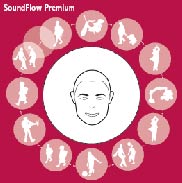
Dybala: Phonak has been known for its work in directional microphone technology. Tell us more about Voice Zoom.
Bongiovanni: As you mentioned, Phonak has set the bar for directional technologies, going back to our AudioZoom technology. VoiceZoom is a 33 channel directional system. Multiple and even moving noise sources can be selectively and simultaneously reduced, for the best possible performance in background noise.
What does that mean to the wearer? When in an environment with various noises coming from different sources (see illustration below) the system has a greater ability to reduce more of the various noises that may interfere with better hearing and understanding... automatically.
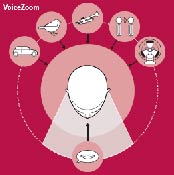
Dybala: Tell us about WhistleBlock.
Bongiovanni: WhistleBlock is the new benchmark in feedback cancellation systems. It has a new, fabulous tagging mechanism that accurately distinguishes between naturally occurring tonal stimuli and true feedback with virtually no artifact. Also, WhistleBlock provides more added stable gain across a broader frequency range. Many systems may provide added stable gain at a narrow range of frequencies;however, with WhistleBlock, we provide added stable gain from frequencies below 2,000 out to beyond 6000 Hz. This is another very exciting development in our Exélia and Naida products.
Dybala: Have you performed any benchmark data looking at your feedback canceller and how many more dB, on average, you are able to offer?
Bongiovanni: Field trial data looking at hearing aid performance with and without WhistleBlock technology, shows a mean of 16.7 dB added stable gain.
Dybala: Let's go back to the wireless capabilities of Exélia. Can you tell us a bit more about iCom, myPilot, and the iCube?
Bongiovanni: I would be happy to. The most important part of the package is the performance of the Exelia - no accessories required! If desired, the wearer may add the myPilot Command Center and/or the iCom.
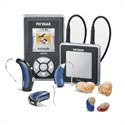
Phonak Exélia, myPilot, and iCom
The myPilot Command Center has a full color display, it is very user friendly and it is easy to operate. It also allows for added functionality, for example, ZoomControl. This function addresses one of the limitations of directional systems;providing maximum sensitivity to the sides or to the rear. In general, the basic premise of all directional systems is that the maximum sensitivity is placed in front of the wearer, right? Look where you want to hear. For the most part, this has been a good strategy, but there are always those cases where the patient may want or need to hear on the side or from the back.
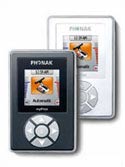
Phonak myPilot Remote Control
For example, the mom in the car who wants to hear her children sitting in the backseat. With ZoomControl, which may be activated automatically or with a button push, one may call out different points of maximum sensitivity. It is now possible for your patient to say, "I want to hear from the right," and with a button push on the myPilot Command Center, one can now change that maximum sensitivity to the right... or to the left.... Or to the back!
Dybala: How have patients been reacting to this?
Bongiovanni: Excited and impressed! They find it very intuitive and easy to operate. I fit a man who is accustomed to using a cell phone and an iPod. He commented that the myPilot works in a similar fashion to those two pieces of technology. This made it quick to learn and very simple to operate the myPilot. A previous wearer, he had typical complaints: "It is hard to hear someone to the right or left of me when I am at a party or a restaurant and I am eating." He was able to easily zoom over to the direction of interest, noticing a significant difference in his ability to hear conversation, especially in noise.
Dybala: I could see that as being a useful control. Let's talk about the iCom.
Bongiovanni: iCom allows unlimited access to wireless communication. The iCom is very small, lightweight, and is worn around the neck. The neck loop is also an antenna to increase range. Square-shaped it has a very large on-off button on the front (see illustration below) for easy accessibility. With iCom, one may connect to any electronic device via Bluetooth, audio sources, and/or FM.
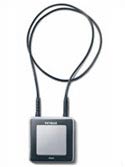
Phonak iCom Communication Interface
With the iCom, the wearer can now connect to the world outside. If using a Bluetooth compatible phone, when the telephone rings, push the button on the iCom and it will connect the call. From the cell phone to the iCom it is transmitting via Bluetooth, from the iCom to both hearing aids it is transmitting via digital inductive technology.
One may connect any portable music device to the iCom via an audio cable. The broad band audio exchange will transmit in stereo.
The FM receiver may be connected via the FM jack on the iCom. One FM receiver will suffice to deliver binaural signal via the iCom to the hearing aids. Now one may have FM functionality with ITE aids!
Our connectivity accessories are also available with Naída! Your patients with severe to profound loss can also enjoy unlimited wireless connectivity.
Dybala: I think it is tremendous to have both the Bluetooth and hardwire options to allow a person with hearing loss to be connected into an unlimited number of devices.
Bongiovanni: Yes, and in combination with good patient selection, the possibilities are limitless! It is important to pick your patients carefully. Not all of our patients are going to have the ability, need and/or the desire to add accessories to their hearing aids, and that is fine. Again, the performance is the main issue with our new products. The connectivity and the control are icing on the cake, and it can mean a critical difference for specific patients that do have the need and have the desire.
Dybala: Absolutely. What about iCube?
Bongiovanni: iCube allows cable free programming. No cable from the computer to the iCube, no cables from the iCube to the hearing instruments! iCube is compatible with any Phonak hearing instrument with wireless capability.
Dybala: Well, Rose, thank you so much for your time. If anyone is interested in more information on Phonak and their latest releases, visit www.phonak.com. We also have a web channel here at Audiology Online at www.audiologyonline.com/channels/phonak.asp, where we have Phonak's latest e learning events, news items, ask the expert postings, and interviews.
With that, Rose, I want to thank you again, and I am sure we will be hearing from Phonak again soon.
Bongiovanni: Thank you, Paul.
More about Phonak
The name Phonak is synonymous with innovation. Based near Zurich, Switzerland, Phonak remains on the cutting edge of hearing instruments and wireless technology. From Exélia's new dimension in sound clarity and accessibility to the expanded possibilities of the Naída and the Inspiro, Phonak's newest line of CORE instruments validates their desire to bring a better quality of life to people of all ages and with all ranges of hearing loss. Phonak truly evokes the philosophy "life is on."
Rose Bongiovanni: Thank you. It is a pleasure to be here Paul.
Dybala: Before we discuss some of the exciting new products that Phonak has released, I would like to start by having you tell us a little bit about yourself and what you do for Phonak.
Bongiovanni: I am the Director of Customer Development, and my job is to oversee training, education, and design strategies to ensure that Phonak maintains its personal touch to all of our customers. It is a job I truly enjoy, as we have great customers!
Dybala: Thanks. Recently, Phonak announced the release of a CORE-based chip technology for hearing aids. This platform would enable, among other things, wireless capabilities in Phonak hearing aids. Could you tell us more about CORE?
Bongiovanni: CORE, as you said, is our new chip that is a brand new platform. The acronym stands for Communication Optimized Real audio Engine. It is actually three chips in one that is very, very small in its packaging. It allows us to offer never before seen performance characteristics, and it also affords us the ability to offer digital wireless. This includes wireless communication between left and right hearing aids and/or communication between the hearing aids and leading-edge accessories.
Dybala: You also have three new products that you are rolling out around this new CORE based chip technology, the Exélia, the Naída, and the Inspiro. Can you give us a brief overview of what these three new products are and what they do?



Bongiovanni: Yes. Exélia is our new premium product. We have identified three main drivers to ensure maximum client benefit: 1) performance, the hearing aid has to perform in as many listening environments as possible;2) control, for those people that want control, although it is designed to be an automatic system;and 3) connectivity, which is where the digital wireless function comes in.

The Phonak Exélia
The Naída is a product designed for people with severe to profound hearing loss. Many times, as new technologies develop, that population of patients is not able to take advantage of the new technology. However, we now have the Naída, which is available in two price points, the Naída V - business class and the Naída III - economy class. It also is available as an Ultra Power, utilizing a 675 battery and as a Super Power, utilizing a 13 battery.
The Naída provides more hearing for the severe to profound population, a very slim design, and it is also water resistant.

The Phonak Naída Ultra Power Hearing System
Dybala: Water-resistance is a big factor, especially for the pediatric population.
Bongiovanni: It is a very important feature. In addition, we are introducing a new integrated FM boot with Naida for those children utilizing FM in the classroom, and it maintains its water resistance capability.

Naída Hearing Instrument with Inspiro Dynamic FM Receivers
Dybala: Tell us about your new FM device, the Inspiro.
Bongiovanni: Yes, it is a new FM device. One of the main features of this new platform is Dynamic FM. As we all know, the classroom can be a very noisy place, and sometimes, it is still challenging for children to hear the teacher's voice in that noisy classroom setting. This product, with its Dynamic FM, is designed to keep its dynamic range above the classroom noise. Additional gain is added if the background noise level increases. The dynamic range 'slides' lower when the classroom is quieter, higher when the classroom is noisier.

Inspiro Transmitter for Schools
Dybala: Let's talk some more about your new premium product, the Exélia. What has Phonak done to enhance performance in this new premium product?
Bongiovanni: There are three main performance characteristics of Exélia. First is the SoundFlow Premium, the second is VoiceZoom, and the third is WhistleBlock. We also maintained many of the characteristics of our previous platforms that perform so well, such as our SoundRelax and Real Ear Sound. In addition, Echo Block, for those people in reverberant situations, and WindBlock, for wind noise management, which stays in a directional mode when wind noise is present.
Dybala: Tell me more about SoundFlow Premium.
Bongiovanni: As you know, Phonak has developed and utilized a multi based platform. In other words, as in Savia Art, we begin with four base programs that activate automatically depending on the environment: calm, comfort in noise, speech in noise, and music. One advantage to this approach is the ability to independently fine tune each 'base' thus solving one problem without creating another.
With the Exélia technology, we have taken multi-base to the next level with our SoundFlow Premium. Instead of choosing one of the base programs that is the best compromise for a given environment, SoundFlow utilizes four configuration points to build and blend elements of each point creating a unique program optimized for that setting.
If your patient is in a noisy situation, music is playing as he/she listens to a talker and the noise dominates, the processor may go into comfort in noise. But with SoundFlow Premium in Exélia, we now blend between configuration points to provide the optimal setting. Field trials have shown great patient acceptance, when moving from one environment to another and for maximum audibility in a variety of environments.

Dybala: Phonak has been known for its work in directional microphone technology. Tell us more about Voice Zoom.
Bongiovanni: As you mentioned, Phonak has set the bar for directional technologies, going back to our AudioZoom technology. VoiceZoom is a 33 channel directional system. Multiple and even moving noise sources can be selectively and simultaneously reduced, for the best possible performance in background noise.
What does that mean to the wearer? When in an environment with various noises coming from different sources (see illustration below) the system has a greater ability to reduce more of the various noises that may interfere with better hearing and understanding... automatically.

Dybala: Tell us about WhistleBlock.
Bongiovanni: WhistleBlock is the new benchmark in feedback cancellation systems. It has a new, fabulous tagging mechanism that accurately distinguishes between naturally occurring tonal stimuli and true feedback with virtually no artifact. Also, WhistleBlock provides more added stable gain across a broader frequency range. Many systems may provide added stable gain at a narrow range of frequencies;however, with WhistleBlock, we provide added stable gain from frequencies below 2,000 out to beyond 6000 Hz. This is another very exciting development in our Exélia and Naida products.
Dybala: Have you performed any benchmark data looking at your feedback canceller and how many more dB, on average, you are able to offer?
Bongiovanni: Field trial data looking at hearing aid performance with and without WhistleBlock technology, shows a mean of 16.7 dB added stable gain.
Dybala: Let's go back to the wireless capabilities of Exélia. Can you tell us a bit more about iCom, myPilot, and the iCube?
Bongiovanni: I would be happy to. The most important part of the package is the performance of the Exelia - no accessories required! If desired, the wearer may add the myPilot Command Center and/or the iCom.

Phonak Exélia, myPilot, and iCom
The myPilot Command Center has a full color display, it is very user friendly and it is easy to operate. It also allows for added functionality, for example, ZoomControl. This function addresses one of the limitations of directional systems;providing maximum sensitivity to the sides or to the rear. In general, the basic premise of all directional systems is that the maximum sensitivity is placed in front of the wearer, right? Look where you want to hear. For the most part, this has been a good strategy, but there are always those cases where the patient may want or need to hear on the side or from the back.

Phonak myPilot Remote Control
For example, the mom in the car who wants to hear her children sitting in the backseat. With ZoomControl, which may be activated automatically or with a button push, one may call out different points of maximum sensitivity. It is now possible for your patient to say, "I want to hear from the right," and with a button push on the myPilot Command Center, one can now change that maximum sensitivity to the right... or to the left.... Or to the back!
Dybala: How have patients been reacting to this?
Bongiovanni: Excited and impressed! They find it very intuitive and easy to operate. I fit a man who is accustomed to using a cell phone and an iPod. He commented that the myPilot works in a similar fashion to those two pieces of technology. This made it quick to learn and very simple to operate the myPilot. A previous wearer, he had typical complaints: "It is hard to hear someone to the right or left of me when I am at a party or a restaurant and I am eating." He was able to easily zoom over to the direction of interest, noticing a significant difference in his ability to hear conversation, especially in noise.
Dybala: I could see that as being a useful control. Let's talk about the iCom.
Bongiovanni: iCom allows unlimited access to wireless communication. The iCom is very small, lightweight, and is worn around the neck. The neck loop is also an antenna to increase range. Square-shaped it has a very large on-off button on the front (see illustration below) for easy accessibility. With iCom, one may connect to any electronic device via Bluetooth, audio sources, and/or FM.

Phonak iCom Communication Interface
With the iCom, the wearer can now connect to the world outside. If using a Bluetooth compatible phone, when the telephone rings, push the button on the iCom and it will connect the call. From the cell phone to the iCom it is transmitting via Bluetooth, from the iCom to both hearing aids it is transmitting via digital inductive technology.
One may connect any portable music device to the iCom via an audio cable. The broad band audio exchange will transmit in stereo.
The FM receiver may be connected via the FM jack on the iCom. One FM receiver will suffice to deliver binaural signal via the iCom to the hearing aids. Now one may have FM functionality with ITE aids!
Our connectivity accessories are also available with Naída! Your patients with severe to profound loss can also enjoy unlimited wireless connectivity.
Dybala: I think it is tremendous to have both the Bluetooth and hardwire options to allow a person with hearing loss to be connected into an unlimited number of devices.
Bongiovanni: Yes, and in combination with good patient selection, the possibilities are limitless! It is important to pick your patients carefully. Not all of our patients are going to have the ability, need and/or the desire to add accessories to their hearing aids, and that is fine. Again, the performance is the main issue with our new products. The connectivity and the control are icing on the cake, and it can mean a critical difference for specific patients that do have the need and have the desire.
Dybala: Absolutely. What about iCube?
Bongiovanni: iCube allows cable free programming. No cable from the computer to the iCube, no cables from the iCube to the hearing instruments! iCube is compatible with any Phonak hearing instrument with wireless capability.
Dybala: Well, Rose, thank you so much for your time. If anyone is interested in more information on Phonak and their latest releases, visit www.phonak.com. We also have a web channel here at Audiology Online at www.audiologyonline.com/channels/phonak.asp, where we have Phonak's latest e learning events, news items, ask the expert postings, and interviews.
With that, Rose, I want to thank you again, and I am sure we will be hearing from Phonak again soon.
Bongiovanni: Thank you, Paul.
More about Phonak
The name Phonak is synonymous with innovation. Based near Zurich, Switzerland, Phonak remains on the cutting edge of hearing instruments and wireless technology. From Exélia's new dimension in sound clarity and accessibility to the expanded possibilities of the Naída and the Inspiro, Phonak's newest line of CORE instruments validates their desire to bring a better quality of life to people of all ages and with all ranges of hearing loss. Phonak truly evokes the philosophy "life is on."

